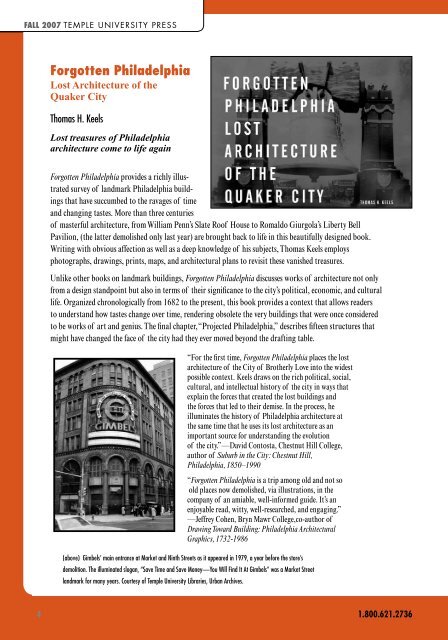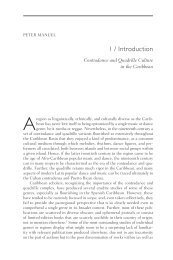New Books - Temple University
New Books - Temple University
New Books - Temple University
You also want an ePaper? Increase the reach of your titles
YUMPU automatically turns print PDFs into web optimized ePapers that Google loves.
Fall 2007 TEMPLE univErsiTy PrEss<br />
4<br />
Forgotten Philadelphia<br />
Lost Architecture of the<br />
Quaker City<br />
Thomas H. Keels<br />
Lost treasures of Philadelphia<br />
architecture come to life again<br />
Forgotten Philadelphia provides a richly illustrated<br />
survey of landmark Philadelphia buildings<br />
that have succumbed to the ravages of time<br />
and changing tastes. More than three centuries<br />
of masterful architecture, from William Penn’s Slate Roof House to Romaldo Giurgola’s Liberty Bell<br />
Pavilion, (the latter demolished only last year) are brought back to life in this beautifully designed book.<br />
Writing with obvious affection as well as a deep knowledge of his subjects, Thomas Keels employs<br />
photographs, drawings, prints, maps, and architectural plans to revisit these vanished treasures.<br />
Unlike other books on landmark buildings, Forgotten Philadelphia discusses works of architecture not only<br />
from a design standpoint but also in terms of their significance to the city’s political, economic, and cultural<br />
life. Organized chronologically from 1682 to the present, this book provides a context that allows readers<br />
to understand how tastes change over time, rendering obsolete the very buildings that were once considered<br />
to be works of art and genius. The final chapter, “Projected Philadelphia,” describes fifteen structures that<br />
might have changed the face of the city had they ever moved beyond the drafting table.<br />
“For the first time, Forgotten Philadelphia places the lost<br />
architecture of the City of Brotherly Love into the widest<br />
possible context. Keels draws on the rich political, social,<br />
cultural, and intellectual history of the city in ways that<br />
explain the forces that created the lost buildings and<br />
the forces that led to their demise. In the process, he<br />
illuminates the history of Philadelphia architecture at<br />
the same time that he uses its lost architecture as an<br />
important source for understanding the evolution<br />
of the city.” —David Contosta, Chestnut Hill College,<br />
author of Suburb in the City: Chestnut Hill,<br />
Philadelphia, 1850–1990<br />
“Forgotten Philadelphia is a trip among old and not so<br />
old places now demolished, via illustrations, in the<br />
company of an amiable, well-informed guide. It’s an<br />
enjoyable read, witty, well-researched, and engaging.”<br />
—Jeffrey Cohen, Bryn Mawr College,co-author of<br />
Drawing Toward Building: Philadelphia Architectural<br />
Graphics, 1732-1986<br />
(above) Gimbels’ main entrance at Market and Ninth Streets as it appeared in 1979, a year before the store’s<br />
demolition. The illuminated slogan, “Save Time and Save Money—You Will Find It At Gimbels” was a Market Street<br />
landmark for many years. Courtesy of <strong>Temple</strong> <strong>University</strong> Libraries, Urban Archives.<br />
.800.62 .2736

















